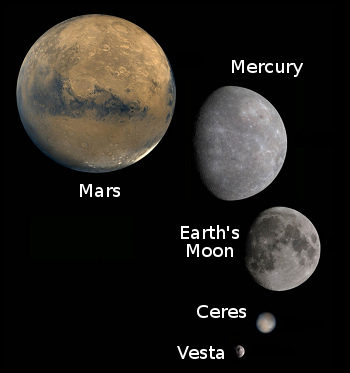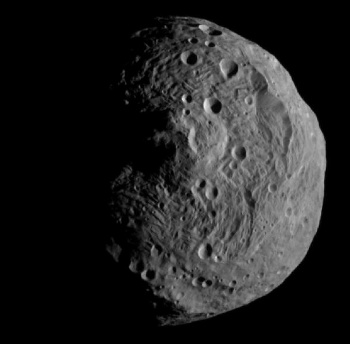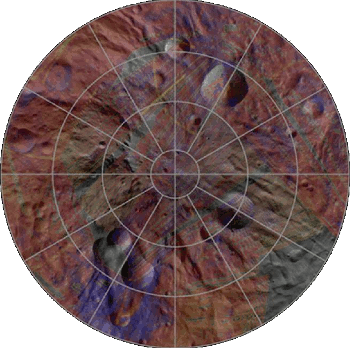Vesta Vistas
May 14, 2012
There's a saying that
bad publicity is better than no publicity at all. No one thought much about the planet,
Pluto, before 2006. Pluto was a sensation when it was discovered by
Clyde Tombaugh in 1930; however, its distance from the
Earth meant that it was imaged as no more than a dot on
photographic plates. In short, not much to inspire the imagination.
The first demotion of Pluto happened in 1978, when it was discovered that our estimates of its size were exaggerated. As it turned out, that little spot of light that we were seeing wasn't just Pluto. Pluto had a
moon, subsequently named
Charon. The name is apt, since
Charon was the ferryman of the underworld, the abode of the
Greek god,
Hades, also known as
Pluto.
Two other moons of Pluto were discovered by the
Hubble Space Telescope in 2005.
The bad press started at the turn of the
century, when there was talk that the now smaller and less impressive Pluto should not really be called a
planet. The
International Astronomical Union decided in 2006 that Pluto was more like a few other, smaller objects in the Solar System, so it demoted Pluto to a "
dwarf planet." It joins four other dwarf planets, one of which is the asteroid
Ceres.
Vesta is the second most massive
asteroid after Ceres. Asteroid Vesta has an estimated 9% of the mass of the
asteroid belt, and it was classified as a planet at its discovery in 1802. Now, it's not even a dwarf planet, but it's still interesting enough to have been visited by
NASA's Dawn spacecraft, the first encounter of which I chronicled in a
previous article (Vesta, July 18, 2011). Dawn entered orbit around Vesta on July 16, 2011, and it's nearing the end of its planned one-year study.[1-4]

Size comparison for Vesta.
Vesta is much smaller than Mars, Mercury, the Moon and Ceres.
(NASA image, modified)
One thing that makes Vesta interesting is that its
density (3.42 g/cc) is quite close to that of
basalt, and it has an
iron core. This makes it very similar to the other
terrestrial planets,
Earth,
Mars,
Venus and
Mercury; so similar that Vesta is called a
protoplanet. A protoplanet is a sizable chunk of material that just didn't reach the size of the other terrestrial planets.

Dawn image of Vesta, July 16, 2011.
Dawn was about 9,500 miles (15,000 kilometers) from Vesta at the time. Image resolution is about 0.88 miles (1.4 kilometers).
(NASA/JPL-Caltech/UCLA/MPS/DLR/IDA image)
Dawn will leave Vesta orbit in a few weeks, and then travel 96,000 miles to Ceres. It's expected to reach Ceres in February 2015. Ceres is quite unlike Vesta. It's about 950
kilometers in diameter, it has a low density (2.08 g/cc), and it's likely composed of
water ice and a rocky core.
Since the Vesta phase of Dawn's observations is nearly over, there's been time for
scientists to summarize some of their findings.[5-9] These appear as six articles in the May 11, 2012, issue of
Science.[5]
•
Dawn at Vesta: Testing the Protoplanetary Paradigm, pp. 684-686.
•
Vesta’s Shape and Morphology, pp. 687-690.
•
The Violent Collisional History of Asteroid 4 Vesta, pp. 690-694.
•
The Geologically Recent Giant Impact Basins at Vesta's South Pole, pp. 694-697.
•
Spectroscopic Characterization of Mineralogy and Its Diversity Across Vesta, pp. 697-700.
•
Color and Albedo Heterogeneity of Vesta from Dawn, pp. 700-704.
Dawn snapped more than 20,000 images of Vesta, and it also obtained millions of
spectra. Not surprisingly, Dawn is pock-marked with many
impact craters. The Dawn team expected to find one large crater in the
southern region, but instead found two, one inside the other. These craters are about one and two billion years old.[6] The younger one has been named
Rheasilvia, and the older one has been named
Veneneia.[7] Rheasilvia is unexpectedly young.[8] As if to balance these craters, Vesta also has a mountain about twice the height of
Mount Everest.[6]
There's a strong
north-
south dichotomy in Vesta's cratering. The northern hemisphere has many small craters representative of the asteroid's early history, while the southern hemisphere has the two recent large impacts.[8] Vesta's surface has a wide range of contrast, indicative of various layered
minerals that have been brought to the surface by meteor impacts.[6]

Mineral Diversity at Vesta's South Pole
The purple areas are rich in diogenite minerals (magnesium-rich silicates), and the red areas have more eucrite minerals (iron-rich basalt).
(NASA/JPL-Caltech/UCLA/INAF/MPS/DLR/IDA image).[9]
Vesta's iron core has been confirmed by Dawn's
gravitational field measurements.[6] It appears, also, that the cratering has wiped-out all evidence of
volcanism on Vesta. This would be the case if the volcanism happened only within the first 100 million years of Vesta's formation.[7]

We're nearing the time of Vestalia, June 7 to June 15, the time of year set aside to honor the Roman goddess of hearth and home, Vesta. Vesta is identified with the Greek goddess Hestia. The Vestal Virgins were the priestess order of Vesta, and they were charged with keeping her sacred fire ever burning.
(Vesta image by Wenzel Hollar (1607–1677), from the University of Toronto Wenceslaus Hollar Digital Collection, via Wikimedia Commons, edited).
![]()
References:
- Jia-Rui Cook and Priscilla Vega, "NASA Spacecraft to Enter Asteroid's Orbit on July 15," JPL Press Release, July 14, 2011.
- Alok Jha, "Dawn spacecraft keeps her date with asteroid Vesta 117m miles away," Guardian (UK), July 15, 2011
- Jonathan Amos, "Dawn probe orbits asteroid Vesta," BBC News, July 17, 2011.
- Dawn site at JPL.
- Vesta articles, Science, vol. 336, no. 6082 (May 11, 2012), pp. 684-704.
- Stuart Wolpert, "You're beautiful, Vesta - NASA's UCLA-led Dawn mission shows protoplanet's surprising surface," UCLA Press Release, May 10, 2012.
- Nikki Cassis, "Dawn spacecraft reveals complexities of ancient asteroidal world," Arizona State University Press Release, May 10, 2012.
- Joe Fohn, "Asteroid collision that spawned Vesta's asteroid family occurred more recently than originally thought," Southwest Research Institute News, May 10, 2012.
- Mineral Diversity at Vesta's South Pole, NASA Web Site.
Permanent Link to this article
Linked Keywords: Succès de scandale; bad publicity is better than no publicity at all; Pluto; Clyde Tombaugh; Earth; photographic plate; moon; Charon; Charon-mythology; Greek god; Hades; Pluto-mythology; moons of Pluto; Hubble Space Telescope; century; planet; International Astronomical Union; dwarf planet; Ceres; Vesta; asteroid; asteroid belt; NASA; Dawn spacecraft; Mars; Mercury; Moon; Ceres; density; basalt; iron; terrestrial planet; Earth; Mars; Venus; Mercury; protoplanet; kilometer; water ice; scientist; Science; Dawn at Vesta: Testing the Protoplanetary Paradigm, pp. 684-686; Vesta’s Shape and Morphology, pp. 687-690; The Violent Collisional History of Asteroid 4 Vesta, pp. 690-694; The Geologically Recent Giant Impact Basins at Vesta's South Pole, pp. 694-697; Spectroscopic Characterization of Mineralogy and Its Diversity Across Vesta, pp. 697-700; Color and Albedo Heterogeneity of Vesta from Dawn, pp. 700-704; spectroscopy; spectra; impact crater; southern; Rheasilvia; Veneneia; Mount Everest; north; south; dichotomy; mineral; diogenite minerals; magnesium; silicate; eucrite minerals; iron; basalt; gravitation; gravitational field; volcanism; Vestalia; Vesta-mythology; Greek; Hestia; Vestal Virgins; University of Toronto; Wenceslaus Hollar; Wikimedia Commons.